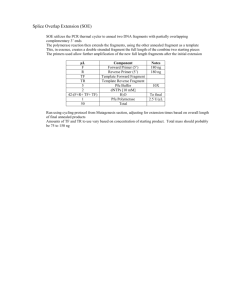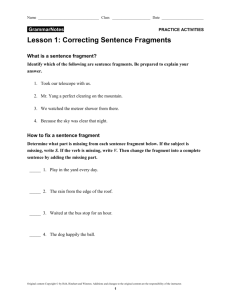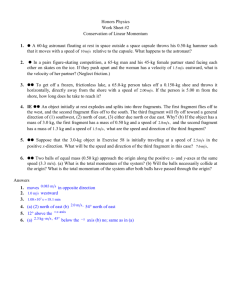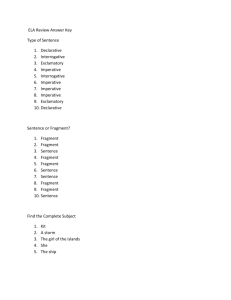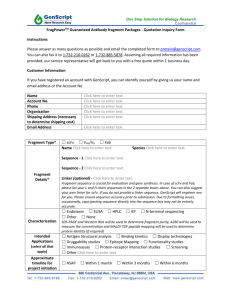HEP_23908_sm_suppinfo
advertisement
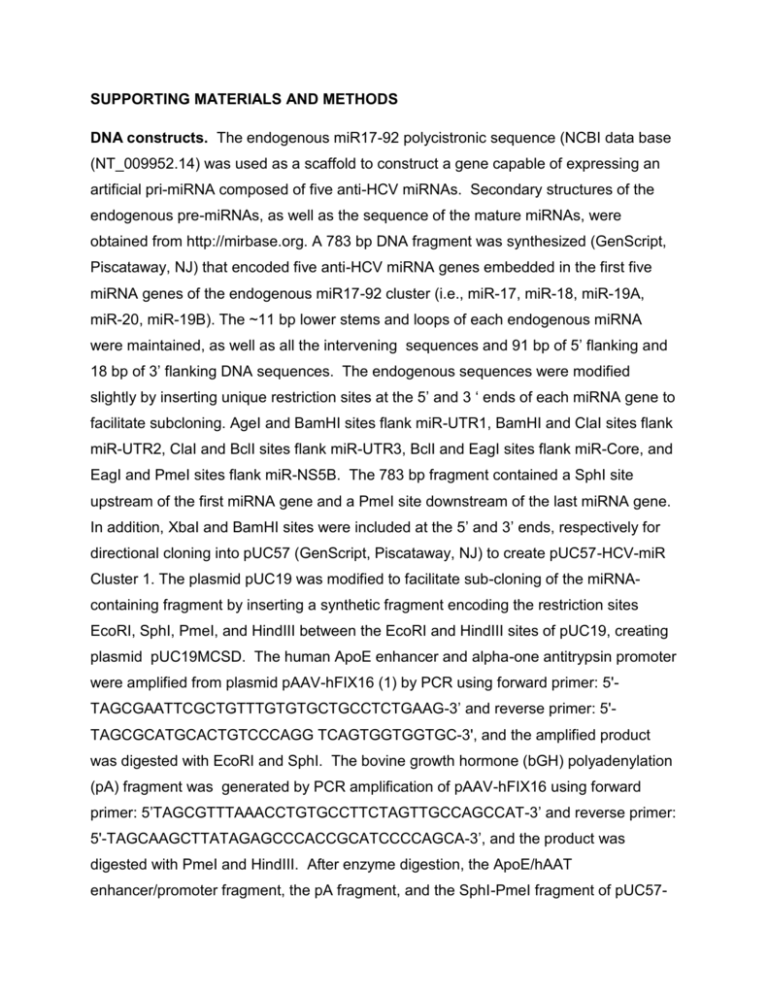
SUPPORTING MATERIALS AND METHODS DNA constructs. The endogenous miR17-92 polycistronic sequence (NCBI data base (NT_009952.14) was used as a scaffold to construct a gene capable of expressing an artificial pri-miRNA composed of five anti-HCV miRNAs. Secondary structures of the endogenous pre-miRNAs, as well as the sequence of the mature miRNAs, were obtained from http://mirbase.org. A 783 bp DNA fragment was synthesized (GenScript, Piscataway, NJ) that encoded five anti-HCV miRNA genes embedded in the first five miRNA genes of the endogenous miR17-92 cluster (i.e., miR-17, miR-18, miR-19A, miR-20, miR-19B). The ~11 bp lower stems and loops of each endogenous miRNA were maintained, as well as all the intervening sequences and 91 bp of 5’ flanking and 18 bp of 3’ flanking DNA sequences. The endogenous sequences were modified slightly by inserting unique restriction sites at the 5’ and 3 ‘ ends of each miRNA gene to facilitate subcloning. AgeI and BamHI sites flank miR-UTR1, BamHI and ClaI sites flank miR-UTR2, ClaI and BclI sites flank miR-UTR3, BclI and EagI sites flank miR-Core, and EagI and PmeI sites flank miR-NS5B. The 783 bp fragment contained a SphI site upstream of the first miRNA gene and a PmeI site downstream of the last miRNA gene. In addition, XbaI and BamHI sites were included at the 5’ and 3’ ends, respectively for directional cloning into pUC57 (GenScript, Piscataway, NJ) to create pUC57-HCV-miR Cluster 1. The plasmid pUC19 was modified to facilitate sub-cloning of the miRNAcontaining fragment by inserting a synthetic fragment encoding the restriction sites EcoRI, SphI, PmeI, and HindIII between the EcoRI and HindIII sites of pUC19, creating plasmid pUC19MCSD. The human ApoE enhancer and alpha-one antitrypsin promoter were amplified from plasmid pAAV-hFIX16 (1) by PCR using forward primer: 5'TAGCGAATTCGCTGTTTGTGTGCTGCCTCTGAAG-3’ and reverse primer: 5'TAGCGCATGCACTGTCCCAGG TCAGTGGTGGTGC-3', and the amplified product was digested with EcoRI and SphI. The bovine growth hormone (bGH) polyadenylation (pA) fragment was generated by PCR amplification of pAAV-hFIX16 using forward primer: 5’TAGCGTTTAAACCTGTGCCTTCTAGTTGCCAGCCAT-3’ and reverse primer: 5'-TAGCAAGCTTATAGAGCCCACCGCATCCCCAGCA-3’, and the product was digested with PmeI and HindIII. After enzyme digestion, the ApoE/hAAT enhancer/promoter fragment, the pA fragment, and the SphI-PmeI fragment of pUC57- HCV-miR Cluster 1 were cloned into the EcoRI and HindIII sites of pUC19MCSD, to generate pUC19MCSD-ApoE/hAAT-HCV-miR Cluster 1 (HCV-miR Cluster 1). The human growth hormone (hGH) intron fragment was generated by PCR amplification of pAAV-LacZ (Stratagene, LaJolla, CA) using forward primer: 5’TAGCGCATGCTTCGAACAGGTAAGCGCC-3’ and reverse primer: 5’TAGCGCATGCAACCTGGGGAGAAACCAG-3’, it was digested with SphI, and was cloned into the SphI site of pUC19MCSD-ApoE/hAAT-HCV-miR Cluster 1, generating pUC19MCSD-ApoE/hAAT-HCV-miR Cluster 1 + Intron (HCV-miR Cluster 1 + Intron). For construction of HCV-miR Cluster 2, a 273 bp DNA fragment was synthesized (GenScript, Piscataway, NJ) that encoded miR-UTR2 and miR-UTR1 embedded in endogenous miR-17 and miR-18 sequences, respectively, and with an AgeI site at the 5’end and a ClaI site at the 3’ end. This fragment was initially cloned into pUC57, and was then used to replace the AgeI-ClaI fragment of pUC19MCSD-ApoE/hAAT-HCVmiR-Cluster 1, creating pUC19MSCD-ApoE/hAAT-HCV-miR Cluster 2 (HCV-miR Cluster 2). For all single miRNA constructs, the individual miRNA fragments were generated by PCR amplification of pUC19-hAAT/ApoE-HCV-miR Cluster 1 using different primers. All forward primers had an AgeI site at their 5’ends and the reverse primers had a PmeI site at their 5’ ends. The individual miRNA fragments replaced the Agel-PmeI fragment of pUC19MCSD-ApoE/hAAT-HCV-miR Cluster 1, generating pUC19MCSD-ApoE/hAAT-HCV-miR-UTR1, pUC19MCSD-ApoE/hAAT-HCV-miRUTR2, pUC19MCSD-ApoE/hAAT-HCV-miR-UTR3, pUC19MCSD-ApoE/hAAT-HCVmiR-Core, and pUC19MCSD-ApoE/hAAT-HCV-miR-NS5B. For construction of pscAAV-HCV-miR Cluster 1, the ApoE HCR/hAAT enhancer/promoter was PCR amplified from pAAV-hFIX16 using forward primer: 5' TAG CGC GAT CGC GCT GTT TGT GTG CTG CCT CTG AAG 3’ and reverse primer: 5’ TAG CGC ATG CAC TGT CCC AGG TCA GTG GTG GTG C3', to generate a fragment flanked by AsiSI and SphI sites. This fragment was co-ligated with the SphIPmeI fragment of HCV-miR Cluster 1 (containing the 5 miRNAs) into the backbone of pscAAV-FIX100 that had first been digested with AsiSI and PmeI. The salient features of the latter fragment are: a wild-type AAV ITR at the 5’ end, the bGH pA sequence, a deleted AAV4 ITR at the 3’ end, and an ampicillin resistance marker. RLuc-HCV reporter plasmids were generated using the psiCheck-2 plasmid (Promega, Madison, WI). HCV target sequences (wild-type, seed mutation, and reverse complement) were synthesized as duplex oligonucleotide pairs (40 bp) (Integrated DNA Technologies, Coralville, IA), and were annealed and ligated between the XhoI and a NotI sites of psiCheck-2, which lie 7-37 nucleotides downstream of the translational stop codon of the RLuc gene. The wild-type reporter sequences are as follows: HCV-UTR1: HCV 1b sequence from 128 to 166 nt, HCV-UTR2: HCV 1b sequence from 264-304 nt, HCV-UTR3: HCV 1b sequence from 311-349 nt, HCV-Core: HCV 1b sequence from 348-387 nt, HCV-NS5B: HCV 1b sequence from 7973-8012 nt. The seed mutation reporter plasmids contain a 3 bp substitution at positions 4-6 of the guide strand target region. The reverse complement reporter plasmids contain the anti-sense sequences relative to the wild-type reporters. The 5 Target reporter contains the five wild-type 40 bp target sequences of the miRNAs arranged in tandem. The psiCheck-2 plasmid also encodes a firefly luciferase (FFLuc) gene to normalize transfection efficiencies. AAV vector production and purification. Recombinant AAV vectors were produced by triple transfection of HEK293 cells, followed by cesium chloride-based purification, as previously described (1). Vectors were pseudotyped with either AAV2 or AAV8 capsids and titered by quantitative real-time PCR (Q-PCR). Northern blot analyses. For analyses of HCVcc RNA, one microgram of total Huh7-5 cellular RNA was run on a 1% alkaline agarose gel and analyzed by Northern blot using an -P32 labeled 9.6 KB fragment of plasmid pJFH-1. The membrane was exposed to film, and developed using a Kodak processor, and was exposed to a phosphor screen and imaged using a Typhoon 9400 imaging system and ImageQuant software (GE Healthcare Bio-Sciences Corp.Piscataway, NJ). For analyses of miRNAs from mouse liver, whole frozen livers were ground using a freezer/mill (Spex CertiPrep, Metuchen, NJ) in liquid nitrogen using three, one minute grinding cycles spaced by three, one minute cooling cycles. Approximately 200 mg frozen ground liver was added to 2 ml of TRIzol reagent (Invitrogen, Carlsbad, CA), and total RNA was extracted according to the manufacturer’s protocol (yield ~0.9 u of total RNA was resolved on 15% denaturing polyacrylamide TBE-urea gels (Invitrogen, Carlsbad, CA) and analyzed by Northern blotting using gamma-P32-ATP labeled oligonucleotide probes Reference List 1. Grimm D, Zhou S, Nakai H, Thomas CE, Storm TA, Fuess S, et al. Preclinical in vivo evaluation of pseudotyped adeno-associated virus vectors for liver gene therapy. Blood 2003;102(7):2412-9.
